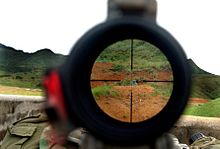Rifle scope
A riflescope is a telescope with a sighting device integrated into the optics. Riflescopes are required in measuring devices and firearms for precise aiming at a distant target. The aiming device is called a reticle . The predecessor of this device is the rear sight .
Basically, the riflescopes are Kepler telescopes according to their design . In modern measuring devices and in rifle scopes for firearms, an erecting lens or an erecting lens system is installed so that an upright image is created. In contrast to the normal telescope, the exit pupil of the ocular system (which coincides with the entry pupil of the eye) is about 8 cm behind the last lens so that the eye is not endangered by the recoil of the weapon.
Rifle scopes are known as closed sights . In contrast to this, the sight consisting of the rear sight and front sight is an open sight . With the riflescope, the reticle and target are shown sharp and enlarged to the eye. On the other hand, when the sights are open, the eye can only focus on all three points at the same time with difficulty because of the different distances between the rear sight, front sight and target.
The classic shape of the reticle is the crosshair or in English crosshair . For this purpose, two threads from a spider web were stretched perpendicular to each other in the image plane of the lens . Today the reticle is etched onto glass. This means that additional markings can be made which can be used in particular for distance estimation (e.g. line (angle unit) - 1 m at 1000 m distance). Reticles that are illuminated by daylight or by electrical equipment are also available today.
Basic structure
All riflescopes have the following elements in common:
- A tubular body, the tube that accommodates the optical elements.
- A lens through which light falls.
- An erecting lens system or an erecting prism system for erecting the image.
- A reticle that can be adjusted upwards, downwards and sideways for adjustment.
- An eyepiece for viewing the image and for focusing on the image plane.
- An assembly for reproducible alignment with respect to the measuring device or the firearm.
In addition, riflescopes still have, depending on the intended use
- a lighting device or an illuminated reticle for use in poor light conditions
- a focus setting for variable target distances
- a spirit level for horizontal alignment, especially when leveling
- variable magnification
- Distance-dependent reticle adjustment
- Variable reticle for distance measurement on total stations
- Field diaphragms to limit the image to rays near the optical axis and thus to limit the parallax error
Use with measuring devices
Because of the required geometrically precise mapping, only apochromats are used. The magnification is between 20 and 60 times in order to achieve the required accuracy .
Measurement errors due to non-centric viewing ( parallax ) and due to assembly errors are taken into account using special measurement methods (see also instrument errors ).
Scopes with zielachsparalleler spirit level ( water level ) are used for leveling . Optical-mechanical total stations show a variable curve in the reticle, which enables the simultaneous reading of distance and height on a measuring stick. Reichenbach spacer threads also serve this purpose .
Use with firearms
Rifle scopes for firearms are designed for a specific purpose: Depending on the situation and purpose, both the shooting distance to the target and the size, shape, speed of movement or background contrast of the target are decisive for the design.
The rifle scope gives the shooter a straight line of sight. In contrast, the projectile flies, depending on its speed, on a trajectory that almost corresponds to a trajectory parabola . Both curves intersect at two points that can be selected by the shooter depending on the intended use. The first point arises when the projectile cuts through the line of sight on its trajectory parabola shortly after leaving the barrel. The second point is called the most favorable bullet distance (GEE) and is the point at which the bullet cuts the line of sight again when falling. The shooter usually sets the telescope's reticle to the distance of the second intersection point or to a value between the two points. Typical shooting distances for hunting are above 100 m.
The rifle scope must be adjusted in relation to the barrel of the firearm so that the same alignment is guaranteed with every shot. This mechanical device for attaching the telescopic sight to the weapon is called an assembly . Depending on the version, this is designed in such a way that the telescopic sight is permanently or detachably connected to the weapon.
For use in different light conditions, different telescopic sights are used accordingly. In daylight, only small magnifications (one to three times) and small lens diameters (e.g. 20 mm) are required.
When there is little daylight or at night, riflescopes with a large entrance pupil (objective diameter), e.g. B. 8x56 preferred, the weight increasing with the lens diameter. Illuminated reticles are increasingly being used, especially at night. Good riflescopes have a coated optics. Extremely thin, anti-reflective coatings are permanently vapor-deposited in many layers on the glass surfaces. The reduction in reflections minimizes the loss of light at the transition layer between gas (e.g. air) and glass. As a result, light transmission values (light permeability values ) of over 99.5 percent are achieved on a transition layer.
See also
literature
- Ilse Haseder , Gerhard Stinglwagner : Knaurs Großes Jagdlexikon , Augsburg 2000, keyword: "Zielfernrohr" p. 961 with reference to "Jagdoptik" p. 419ff, ISBN 3-8289-1579-5
Web links
Individual evidence
- ↑ Rifle scope at ssg-82.de (online PDF 284 KB) ( Memento from June 19, 2012 in the Internet Archive )





